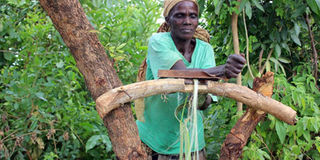Time to revive Kenya’s sisal industry

Ms Lorna Anyango peels sisal leaves at Kosele village in Rachuonyo, Homa Bay County, last year. PHOTO | BARACK ODUOR | NATION MEDIA GROUP
What you need to know:
With the plastic bag industry having been so huge, its collapse is a fitting incentive for entrepreneurs to move quickly to fill the gap with eco-friendly alternatives.
Supermarkets alone hand out 100 million polythene bags a year.
The country is the world’s third-largest producer, with an estimated annual output in 2013 of 28,000 tonnes—about half of it by Rea Vipingo Group.
The ban on polythene bags on Monday presents a good opportunity for Kenyans to innovatively invest in packaging products to replace the plastic carriers.
With the plastic bag industry having been so huge, its collapse is a fitting incentive for entrepreneurs to move quickly to fill the gap with eco-friendly alternatives.
According to the United Nations Environmental Programme (Unep), the industry churns out 24 million plastic bags a month (288 million a year), causing major environmental damage and health problems. Supermarkets alone hand out 100 million polythene bags a year.
The figures point to an industry that could turn over more than Sh3 billion a year.
STOP IMPORTATION
The six-month lead time given by the government to stop the importation, manufacturing and use of polythene bags should have been sufficient for our cottage industries to spring up with reusable and biodegradable alternatives.
These include paper, sisal, canvas, cotton, hyacinth and other materials that have the potential to produce millions of bags and create as many jobs as are being lost as a result of the plastic ban.
The most viable option is to develop and diversify the local sisal industry, which has much better prospects than the struggling cotton industry.
It is also a better bet than the paper industry, which can cause environmental damage because making more paper will mean cutting down more trees.
Sisal produces a natural fibre that is used to make many commercial and ornamental products—including sacks, bags, cordage, specialty paper, carpets and bricks. It is also used as an alternative to glass fibre in cars and furniture.
SISAL INDUSTRY
Although the global sisal industry is huge, Kenya hasn’t maximised the benefits from the crop, because it mainly exports more raw fibre than processed products.
The country is the world’s third-largest producer, with an estimated annual output in 2013 of 28,000 tonnes—about half of it by Rea Vipingo Group.
Global production for 2013 was over 280,000 tonnes. Brazil led at 150,000 tonnes, which has dropped considerably in the past four years, mainly due to drought. Tanzania was second with 35,000 tonnes. Among other major producers were Madagascar, China and Mexico.
Sisal, which is native to southeastern Mexico, was introduced in Kenya in 1907 and first planted in Thika.
A report by Agro Processors International indicates that, by 1965, there were 54 large-scale sisal plantations covering over 120,000 hectares.
JUTE BAGS
Production of 68,000 tonnes of fibre and exports of 58,000 tonnes were recorded that year. The industry employed 20,000 people directly and thousands more indirectly.
Tanzania produced a remarkable 250,000 tonnes.
However, global competition from synthetic products and low international prices have dampened the industry’s fortunes lately.
Massive importation of jute bags in the 1980s contributed to the woes of Kenya’s sisal industry, which suffered a major crisis when its flagship business, East African Bag & Cordage, collapsed with a huge stock of bags that it couldn’t sell.
Land previously under sisal has been converted into other uses—including housing development and international golf courses (for example, in Thika and Vipingo) — perhaps an indicator of how unattractive sisal has become.
VALUE ADDITION
Kenya needs to study the sisal industry value chains and encourage value addition to the low level of sisal products produced.
It should take the cue from the UN, which is promoting sisal and other natural fibres not just as alternatives to plastic but as naturally good for sustainable environment.
The UN General Assembly declared 2009 the Year of Natural Plant and Animal Fibres. The eco-friendly plant fibres on the list are sisal, cotton, abaca, flax, hemp, jute, coir and ramie.
Promoting sisal farming and processing would increase output and jobs, diversify exports and increase export earnings while promoting a sustainable environment.
Time is now, to turn the demise of plastics into an opportunity to develop a new industrial activity around sisal that will contribute to Kenya’s growth and sustainable environment.
Mr Warutere is a director of Mashariki Communications Ltd. [email protected].





